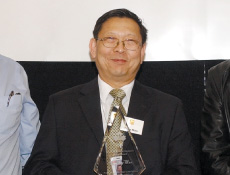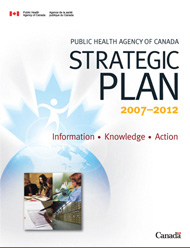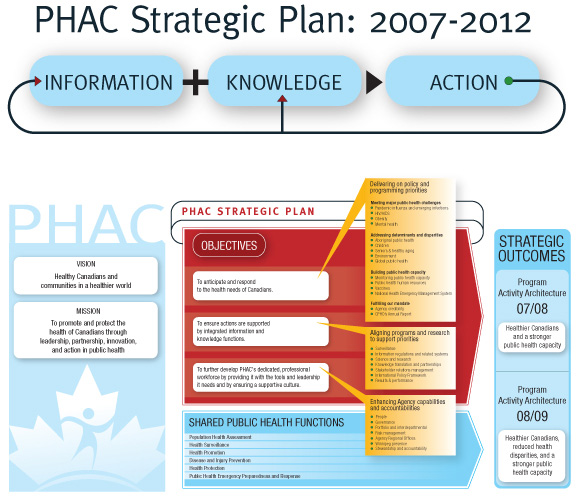Common menu bar links
Institutional links
Diseases & Conditions
Health & Safety
Research & Statistics
Agency Information
Search Box
Strategic Objectives
The diagram below outlines how the vision and mission, strategic objectives and action areas fit together to allow PHAC to contribute to the strategic outcome, in collaboration with a range of partners.
The left side of the document represents the “backdrop” for PHAC’s Strategic Plan. As such, the mission and vision of the Agency remain unchanged and convey the message that the work of the Agency is broader than the areas listed in its Strategic Plan.
The list of public health functions, taken from the Agency’s enabling legislation, shows that action on public health is shared and that a range of partners, both within and outside of federal jurisdiction, are involved in achieving health outcomes. They represent the full range of tools that PHAC uses to collaborate with partners to achieve its strategic outcome.
PHAC has identified three strategic objectives, and a set of action areas stemming from each, to guide its actions over the next five years. This section represents the backbone of the Strategic Plan. The Agency must focus on these areas over the next five years to address key public health challenges, deliver in order to maintain credibility, manage change, increase capacity, realign and realize efficiencies, manage key risks, build an agency culture, maximize opportunities and support its organization and people. These areas do not represent everything that the Agency does nor everything that the Agency considers to be important.
1. Anticipate and respond to the health needs of Canadians
In support of this strategic objective, PHAC will focus on a number of priorities that are critical to its abilities to reduce health disparity and contribute to a stronger public health capacity. Central to this objective will be the ability of the Agency to effectively fulfill its mandate, maintaining credibility and enhancing its already strong reputation. The policy and program priorities in this section are not an exhaustive list of all the issues PHAC will continue to work on or consider important. They represent specific areas where the Agency has made a clear decision to make significant headway over the next five years in addressing major public health challenges, as well as key determinants of health, health disparities among Aboriginal peoples, children, and seniors, and gaps in public health capacity.
In delivering on policy and programming priorities under this objective, PHAC will concentrate on establishing integrated frameworks and delivery mechanisms and a cohesive approach to addressing health determinants. As the Agency moves forward, it will be essential to maintain the links between the priorities and work of the broader Health Portfolio, other departments and other governments.
 Dr. Paul Sandstrom, Dr. Sohail Abbas, Dr. Alix Adrien, and Dr. Chris Archibald provide technical assistance on HIV surveillance and laboratory services to Pakistan as part of the Canada-Pakistan HIV/AIDS Surveillance Project. They assist with the analysis and interpretation of data on high-risk groups which is used to enhance the prevention and control of HIV/AIDS in Pakistan.
Dr. Paul Sandstrom, Dr. Sohail Abbas, Dr. Alix Adrien, and Dr. Chris Archibald provide technical assistance on HIV surveillance and laboratory services to Pakistan as part of the Canada-Pakistan HIV/AIDS Surveillance Project. They assist with the analysis and interpretation of data on high-risk groups which is used to enhance the prevention and control of HIV/AIDS in Pakistan.
 Dr. Yang Mao has worked in the area of disease surveillance for more than 30 years and has published more than 200 articles in peer-reviewed scientific journals. Dr. Mao is a proud recipient of the Science/Medical Research PHAC Merit Award in 2006 and the Queen’s Golden Jubilee Medal (2003) for his remarkable career achievements and strong commitment to the health of Canadians.
Dr. Yang Mao has worked in the area of disease surveillance for more than 30 years and has published more than 200 articles in peer-reviewed scientific journals. Dr. Mao is a proud recipient of the Science/Medical Research PHAC Merit Award in 2006 and the Queen’s Golden Jubilee Medal (2003) for his remarkable career achievements and strong commitment to the health of Canadians.
2. Ensure actions are supported by integrated information and knowledge functions
Programs and research in the Agency will be aligned to support the priorities identified under Objective 1. Key to the success of the alignment will be better linkages between PHAC’s information and knowledge development functions and its actions, as described previously.
3. Further develop PHAC’s dedicated, professional workforce by providing it with the tools and leadership it needs and by ensuring a supportive culture
To continue providing high quality public health programming, research and advice, PHAC needs to ensure that the organization and its people have the necessary organizational, management and cultural supports.
This objective is about making sure that the Agency is well-positioned and equipped to address the first two objectives. Simply put, it is about managing to deliver on priorities.
 As a Senior Policy Advisor, Claude Giroux coordinates and facilitates policy development initiatives and special projects in the area of infectious disease and emergency preparedness. In event of a public health emergency, Claude would form part of the emergency management team liaising with the Emergency Operations Centre (EOC). The EOC is the central nervous system for emergency response within the Agency. It is maintained in a constant state of readiness in order to deal with public health emergencies.
As a Senior Policy Advisor, Claude Giroux coordinates and facilitates policy development initiatives and special projects in the area of infectious disease and emergency preparedness. In event of a public health emergency, Claude would form part of the emergency management team liaising with the Emergency Operations Centre (EOC). The EOC is the central nervous system for emergency response within the Agency. It is maintained in a constant state of readiness in order to deal with public health emergencies.
| Table of Contents |
Next page |


